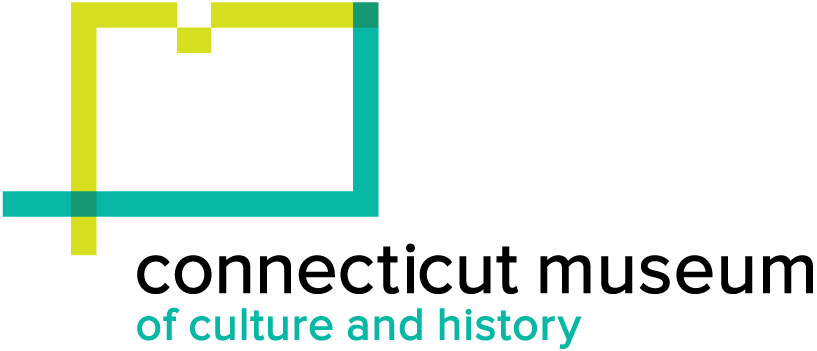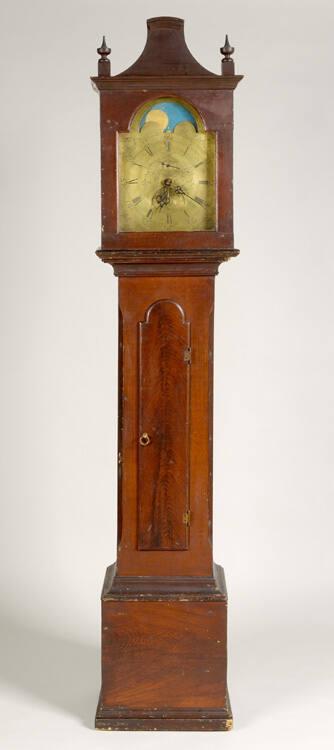Tall Case Clock
ClockmakerWorks made by
Daniel White Griswold
(American, 1767 - 1844)
Furniture MakerCase made by
Unknown
Date1790-1800
MediumCase: Pine primary wood, paint.
Dial: Brass, paint.
Clock Works: Wood.
DimensionsPrimary Dimensions (overall height x width x depth): 84 3/4 x 18 1/16 x 13in. (215.3 x 45.9 x 33cm)
ClassificationsClocks
Credit LineGift of Mrs. Gordon D. Skinner, Charles E. Hubbard, James H. Hubbard, Grace M. Hubbard, and George D. Hubbard, in memory of William F. Hubbard
Object number1950.249.0
DescriptionTall case clock in the Chippendale, or rococo, style, with a pine case, a wooden clock movement, and a brass dial that is engraved "Dan. Griswold East-Hartford". The tall case clock consists of three major components: the removable hood, the removable dial and clock works, and the clock case. The dial and works sit on a horizontal board at the top of the clock case; the pendulum and weights (weights are detached) that drive the works are suspended in the trunk, or narrow body, of the case. The hood slides over the works and sits at the top of the case.
At the top of the flat-top hood are two finials, each consisting of a slender cone atop an urn. Each finial sits at the top of a square plinth. At the center of the hood is a tall, arched pediment; molding applied at the top front and sides of the pediment flares out gradually to meet the plinths. The front of the hood has a glass door that is arched. The trunk of the clock case has deep cove, or recessed quarter-circle, molding at the top and bottom; a tall rectangular door with an arched top; and chamfered, or angled, front corners. All four sides of the door are edged with ovolo, or thumbnail, molding. The rectangular base of the clock case has base molding and no feet. The exterior of the pine case is faux grained, or painted with translucent brown paint to imitate the grain found in a different wood. The interior of the case is painted light brown.
Construction Details: A single, vertically-oriented backboard with squared top corners extends the full height of the hood and case. The hood does not have a back; it slides over the clock works to rest on the cove molding at the top of the trunk. The hood is constructed of a three-part frame, with a top and two sides that are joined with a nailed butt joint at the top corners. All ornament is nailed or glued to this frame: the pediment, the plinths, and the molding at the top and bottom edges of the hood. The front of the hood has a square, glass window with an arched top edge. The glass is contained in a frame with rails that are tenoned and pinned at each corner. The front of the hood is stationary; there is no door.
The front, sides, and back of the trunk are joined at each corner with nailed butt joints. The boards that form the sides of the trunk extend several inches above the bottom of the hood. The clock works rest on a seat board, or horizontal board immediately behind the dial. The seat board rests on two wedges of wood at the top of the sides of the trunk. The cove molding is nailed to the front and sides of the top of the trunk, and to the joint between the sides of the trunk and the top of the base. The opening for the door is cut out of the solid board that forms the front of the trunk. The door is constructed of a single board that is joined to the trunk with two brass hinges at the right side; there is a round pull at the center left side. The boards that form the sides of the trunk extend down to the floor. The front, sides, and back of the base are joined with nailed butt joints. There is no bottom board on the base. The base molding is nailed to the front and sides of the base.
Dial: The engraved, brass dial is square with an arched top; it is painted white. The dial arch contains a recessed, painted moon dial that is behind two engraved depictions of the globe. The middle of the square dial plate is engraved with a chapter ring, consisting of a ring of Roman numerals, inside a ring of minute gradations, inside a ring of Arabic numbers from one to sixty in increments of five. In the center of the chapter ring is an arbor, or axle, around which the hour and minute hands pivot. An seconds dial is engraved above the main arbor, with a lead hand pivoting around the center. To the left of the main arbor is engraved "Dan Griswold", and to the right is engraved "E. Hartford". This engraving is above a recessed, arched calendar dial. Additional scroll and leaf designs are engraved in the center of the chapter ring and at each corner of the dial plate.
Clock Works
Movement: weight powered
Duration: thirty hours
Materials: wood; oak plates, cherry wheels
Strike: count wheel
Escapement: recoil
The works are accompanied by a pendulum bob with a brass face and two cylindrical tin weights.
Condition: The paint on the case is lightly scratched, with chips around the nail holes. The paint has flaked or rubbed off of the molding at the top and bottom of the base, especially at the corners. The dial was silvered originally. On the dial, the face on the moon is missing, and the stars have been painted over. Some pins are missing from the dial, causing the hands to fall off. All weights, consisting of the pendulum bob and two cylindrical weights, are separated from the clock works. The long wooden shaft that forms the pendulum is missing.
At the top of the flat-top hood are two finials, each consisting of a slender cone atop an urn. Each finial sits at the top of a square plinth. At the center of the hood is a tall, arched pediment; molding applied at the top front and sides of the pediment flares out gradually to meet the plinths. The front of the hood has a glass door that is arched. The trunk of the clock case has deep cove, or recessed quarter-circle, molding at the top and bottom; a tall rectangular door with an arched top; and chamfered, or angled, front corners. All four sides of the door are edged with ovolo, or thumbnail, molding. The rectangular base of the clock case has base molding and no feet. The exterior of the pine case is faux grained, or painted with translucent brown paint to imitate the grain found in a different wood. The interior of the case is painted light brown.
Construction Details: A single, vertically-oriented backboard with squared top corners extends the full height of the hood and case. The hood does not have a back; it slides over the clock works to rest on the cove molding at the top of the trunk. The hood is constructed of a three-part frame, with a top and two sides that are joined with a nailed butt joint at the top corners. All ornament is nailed or glued to this frame: the pediment, the plinths, and the molding at the top and bottom edges of the hood. The front of the hood has a square, glass window with an arched top edge. The glass is contained in a frame with rails that are tenoned and pinned at each corner. The front of the hood is stationary; there is no door.
The front, sides, and back of the trunk are joined at each corner with nailed butt joints. The boards that form the sides of the trunk extend several inches above the bottom of the hood. The clock works rest on a seat board, or horizontal board immediately behind the dial. The seat board rests on two wedges of wood at the top of the sides of the trunk. The cove molding is nailed to the front and sides of the top of the trunk, and to the joint between the sides of the trunk and the top of the base. The opening for the door is cut out of the solid board that forms the front of the trunk. The door is constructed of a single board that is joined to the trunk with two brass hinges at the right side; there is a round pull at the center left side. The boards that form the sides of the trunk extend down to the floor. The front, sides, and back of the base are joined with nailed butt joints. There is no bottom board on the base. The base molding is nailed to the front and sides of the base.
Dial: The engraved, brass dial is square with an arched top; it is painted white. The dial arch contains a recessed, painted moon dial that is behind two engraved depictions of the globe. The middle of the square dial plate is engraved with a chapter ring, consisting of a ring of Roman numerals, inside a ring of minute gradations, inside a ring of Arabic numbers from one to sixty in increments of five. In the center of the chapter ring is an arbor, or axle, around which the hour and minute hands pivot. An seconds dial is engraved above the main arbor, with a lead hand pivoting around the center. To the left of the main arbor is engraved "Dan Griswold", and to the right is engraved "E. Hartford". This engraving is above a recessed, arched calendar dial. Additional scroll and leaf designs are engraved in the center of the chapter ring and at each corner of the dial plate.
Clock Works
Movement: weight powered
Duration: thirty hours
Materials: wood; oak plates, cherry wheels
Strike: count wheel
Escapement: recoil
The works are accompanied by a pendulum bob with a brass face and two cylindrical tin weights.
Condition: The paint on the case is lightly scratched, with chips around the nail holes. The paint has flaked or rubbed off of the molding at the top and bottom of the base, especially at the corners. The dial was silvered originally. On the dial, the face on the moon is missing, and the stars have been painted over. Some pins are missing from the dial, causing the hands to fall off. All weights, consisting of the pendulum bob and two cylindrical weights, are separated from the clock works. The long wooden shaft that forms the pendulum is missing.
Status
Not on view










